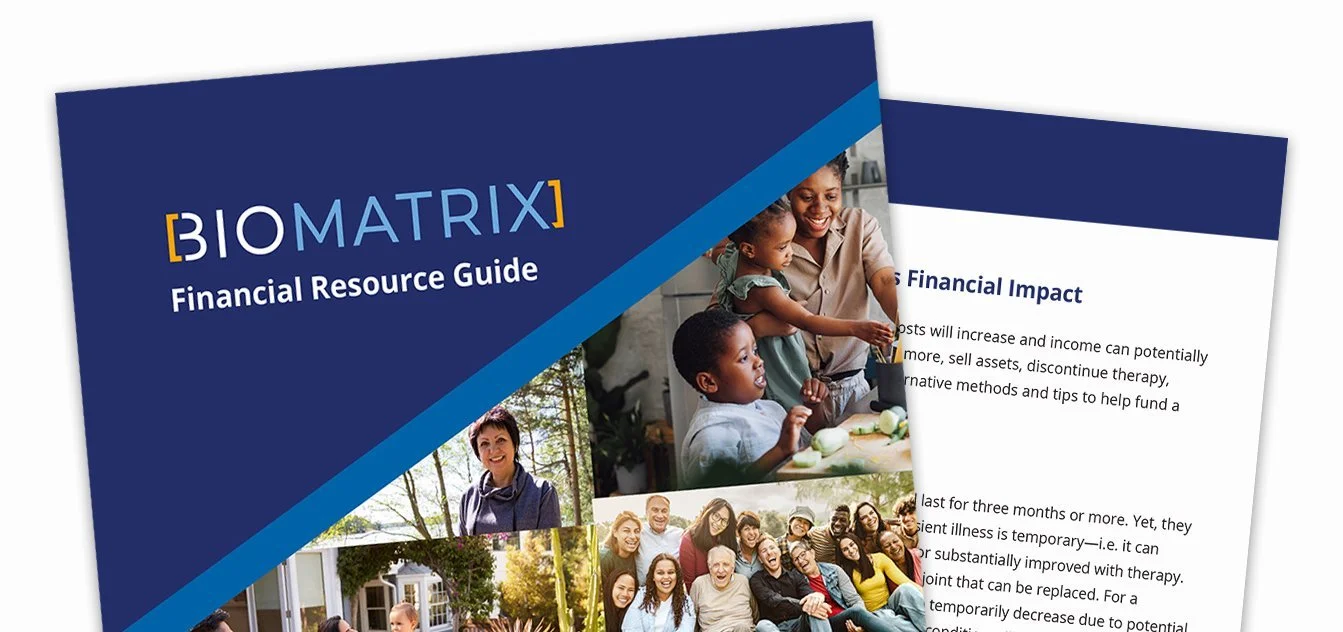By Justin Lindhorst and Regina Valenzuela
Have you ever felt confused or unsure about your healthcare coverage? If you answered yes, you’re not alone. In fact, a recent survey found 56% of Americans report feeling “completely lost” when it comes to understanding their health insurance.1
For patients taking specialty medications, understanding coverage can be even more challenging. This article provides an overview of specialty drug coverage under the medical and pharmacy benefit and includes links to additional resources to help you understand your health insurance.
Background
In the past, health services were all covered under the insurance plan’s “major medical” benefits – the pharmacy benefit did not exist. Starting in the 1960s, insurance companies began providing coverage for prescription medication. The first Pharmacy Benefit Managers (PBMs) were created during this time to act as an intermediary, help health insurance companies control cost, set prescription drug formularies, and process a large volume of prescription drug claims. PBM management of prescription drugs helped create a separate administrative structure outside of major medical benefits for prescription drugs – the pharmacy benefit. In today’s healthcare landscape, the three biggest PBMs control pharmacy benefits for nearly 270 million Americans.2
According to the Kaiser Family Foundation, 48.5% of the population in the United States have health coverage through their employer; 6.1% have individual non-group coverage; 21.1% have Medicaid, 14.3% have Medicare, and 1.3% have military health coverage.3 Coverage for prescription medication varies across each of these different health plans. For employer based, non-group individual coverage, Medicaid, and TRICARE – coverage for health services are managed under a pharmacy benefit and medical benefit. Health insurance companies typically manage their own medical benefit package, but some choose to outsource management of their pharmacy benefit to a separate PBM. This is why some patients have a medical benefits card, and a separate pharmacy benefit prescription drug card. For patients on Medicare – Part A covers in-patient services/hospitalization; Part B is the “medical benefit,” providing coverage for out-patient services, home-health care, and most infused specialty medications; and Medicare Part D covers pharmacy benefits.
Pharmacy Benefit
Many patients who are prescribed specialty medication receive training from a medical provider so they can take their medicine at home. This includes patients on oral, topical, intravenous, or subcutaneous therapies. Specialty medication is typically covered under the pharmacy benefit when the patient self-administers the prescribed medication at home. When a specialty medication is covered under the pharmacy benefit, the insurance company’s PBM has a lot of control over how and whena patient can access their prescribed medicine. Patients may be subject to formulary restrictions, step-therapy, specialty pharmacy mandates, and copay accumulators. Under the pharmacy benefit, drugs are placed into a classification system of different tiers. Lower cost or generic drugs are typically tier I, and specialty medications mostly fall into tier IV – the highest tier. Drug tiers impact patient out-of-pocket costs such as copay and coinsurance. The higher the tier, the greater the out-of-pocket expense for the patient. Coverage under the pharmacy benefit may also be subject to a deductible or max out-of-pocket separate from the medical benefit. Tier IV medications are also subject to more PBM utilization management techniques such as prior authorization. Patients may need to work with their specialty pharmacy and medical provider to demonstrate “medical necessity” for their prescribed medication before they can receive it.
Medical Benefit
Coverage for specialty medication under the medical benefit typically occurs when the drug is administered by a health care professional in a hospital, physician office, or infusion center. Providers often use the “Buy and Bill” method where the drug is purchased and kept by the provider and then the claim is billed to the insurance company after the medication is administered to the patient. The insurance company reviews the claim, and the provider is paid at a later date. Out of pocket expenses for specialty drugs processed under the medical benefit often include deductible, co-pay, and or coinsurance. For patients who have Medicare, 80% of the office-administered drug is covered by Medicare Part B, with the remaining 20% picked up by a supplemental plan purchased by the patient.4 Coverage under the medical benefit occurs independent of the plan’s PBMs, which means patients may avoid some of the formulary restrictions, step-therapy, or pharmacy mandates imposed under the pharmacy benefit.
But Wait! There’s More.
In the world of health insurance, “It depends” is a common answer to many coverage questions. As previously mentioned, specialty medication is typically covered under the pharmacy benefit if self-injected/self-administered and under the medical benefit when administered by a healthcare provider. But there are cases where coverage is offered for self-injected medication under the medical benefit – typically under employer-based or non-group commercial health plans. Coverage provided for self-injected medication under the medical benefit may be an attractive option for patients who do not wish to have their pharmacy mandated to them by a PBM, when the pharmacy benefit includes step-therapy, a copay accumulator, or the prescribed drug is not included on the pharmacy benefit formulary.
For patients on Medicare – it’s important to know that most infused specialty medications such as factor products for patients with a bleeding disorder are covered under Medicare Part B, not Medicare Part D. This has a significant impact on out-of-pocket costs because under Part B, 80% of the drug is covered by Medicare, and the remaining 20% is picked up by the patient’s supplemental plan. Under Medicare Part D, there is currently no max-out-of-pocket for prescription drugs – though there is legislation that will begin to address this issue in 2023.
Another important consideration is how claims billed to the pharmacy or medical benefit impact a patient’s deductible and max out-of-pocket. Many patients with a chronic, expensive, lifelong condition become accustomed to meeting their deductible or max out-of-pocket with their first shipment of medication in the new year. This is because when covered under the pharmacy benefit, associated out-of-pocket costs are immediately applied toward the deductible and max out-of-pocket. Under the medical benefit, the claim submitted by the provider’s office who administered the drug undergoes review before it is approved. This can take time, and associated out-of-pocket expenses take longer to be applied toward a patient’s deductible and max out-of-pocket.
Still Confused? Your Specialty Pharmacy Can Help.
Health insurance is confusing. The healthcarelandscape in the United States is complex and fragmented, and it’s often a good idea to tap an expert to better understand your health coverage. Reputable specialty pharmacies employ teams of experts in insurance billing and reimbursement. These teams understand how to properly secure authorization for prescribed specialty therapies, how to correctly bill insurance plans for services, and how to connect patients with appropriate resources and programs focused on reducing financial burden. They can also help patients to better understand their coverage for specialty medication by conducting a benefits investigation. A thorough benefits investigation completed by an expert can help patients gain a solid understanding of their coverage options and associated out-of-pocket expenses for specialty medication under their insurance plan – without the jargon and red tape.
BioMatrix is an infusion-focused specialty pharmacy supporting patients with bleeding disorders, autoimmune disorders, neurological disorders, and other rare health conditions. If you’d like assistance understanding how your specialty medication is covered—we can help. Use the form below and we’ll conduct a no-obligations benefit investigation to help you understand coverage for your prescribed specialty infusion therapy.
Financial Resource Guide
Living with a chronic condition can create additional healthcare costs while also impeding one’s ability to work. Our financial resource guide can help.
Read More Article About Health Insurance:
The Right to the Right Coverage - Patient Rights and Health Insurance Policies
Understanding Medicare Coverage
Understanding Medicare Coverage Gaps
Understanding Medicare Eligibility
Understanding Step Therapy Mandates
Understanding Redetermination for Medicaid and CHIP Beneficiaries
DISCLAIMER: THIS IS NOT MEDICAL ADVICE. All information, content, and material is for informational purposes only and is not intended to serve as a substitute for the consultation, diagnosis, and/or medical treatment of a qualified physician or healthcare provider. Please consult a physician or other health care professional for your specific health care and/or medical needs or concerns and never disregard professional medical advice or delay in seeking it because of something you have read here or on our website.
Stay informed on the latest trends in healthcare and specialty pharmacy.
Sign up for our monthly e-newsletter, BioMatrix Abstract.
By giving us your contact information and signing up to receive this content, you'll also be receiving marketing materials by email. You can unsubscribe at any time. We value your privacy. Our mailing list is private and will never be sold or shared with a third party. Review our Privacy Policy here.




















